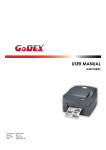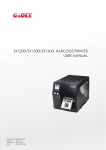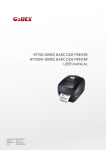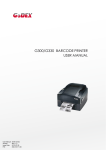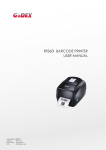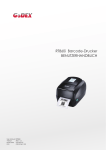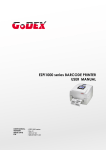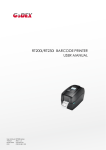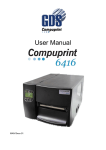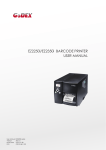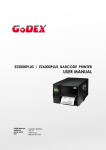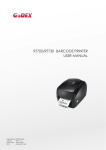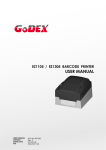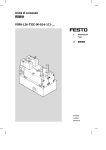Download EZ2050/EZ2150 BARCODE PRINTER USER MANUAL
Transcript
EZ2050/EZ2150 BARCODE PRINTER USER MANUAL User Manual : EZ2050 series Version : Rev. D Issue Date : 2013.07.18 P/N : 920-014411-00 1 EZ2050/EZ2150 USER MANUAL CONTENTS 1. BARCODE PRINTER ...................................................................... 1 1-1. Box content .............................................................................................1 1-2. Getting to know your printer .................................................................2 2. PRINTER SETUP ............................................................................. 4 2-1. Loading the label roll .............................................................................4 2-2. Loading the ribbon .................................................................................7 2-3. Connecting the printer to the host computer ...................................8 2-4. Installing the driver ..................................................................................9 3. OPERATOR PANEL ..................................................................... 11 3-1. Operator panel – introduction .......................................................... 11 3-2. Function buttons – introduction......................................................... 12 3-3. Settings mode ...................................................................................... 13 3-4. Label Calibration and Self Test .......................................................... 15 3-5. Dump mode ......................................................................................... 17 3-6. Error alerts .............................................................................................. 18 4. ACCESSORIES ........................................................................... 19 4-1. internal rewinder .................................................................................. 19 4-2. Installing the rewinder guide.............................................................. 21 4-3. Label dispenser .................................................................................... 22 4-4. Installing the cutter .............................................................................. 24 4-5. Installing the Parallel adapter ............................................................ 26 4-6. Installing the Applicator interface .................................................... 28 5. MAINTENANCE AND ADJUSTMENT .......................................... 30 5-1. Installing / removing the print head module................................... 30 5-2. Adjusting the print line ........................................................................ 31 5-3. Adjusting the ribbon tension .............................................................. 32 5-4. Cleaning the thermal print head ...................................................... 33 5-5. Adjusting the balance and print head tension .............................. 34 5-6. Ribbon shield settings .......................................................................... 35 5-7. Cutter settings ...................................................................................... 36 5-8. Troubleshooting.................................................................................... 37 APPENDIX Contents Contents EZ2050/EZ2150 USER MANUAL FCC COMPLIANCE STATEMENT FOR AMERICAN USERS This equipment has been tested and found to comply with the limits for a CLASS A digital device, pursuant to Part 15 of the FCC Rules. These limits are designed to provide reasonable protection against harmful interference when the equipment is operated in a commercial environment. This equipment generates, uses, and can radiate radio frequency energy and, if not installed and used in accordance with the instructions, may cause harmful interference to radio communications. Operation of this equipment in a residential area is likely to cause harmful interference in which case the user will be required to correct the interference at own expense. EMS AND EMI COMPLIANCE STATEMENT FOR EUROPEAN USERS This equipment has been tested and passed with the requirements relating to electromagnetic compatibility based on the standards EN 55022:2010 Class A, EN61000-3-2:2006/A2:2009, EN 61000-3-3:2008 and EN 55024:1998/A1:2001/A2:2003, IEC 61000-4-2:2008 series, The equipment also tested and passed in accordance with the European Standard EN55022 for the both Radiated and Conducted emissions limits. EZ2050 SERIES TO WHICH THIS DECLARATION RELATES IS IN CONFORMITY WITH THE FOLLOWING STANDARDS IEC 60950-1:2005(2nd Edition)+Am 1:2009, GB4943-2001 GB9254-2008(Class A) GB17625.1-2003, EN 55022:2010 Class A, EN61000-3-2:2006/A2:2009, N 61000-3-3:2008 and EN 55024:1998/A1:2001/A2:2003, IEC 61000-4-2:2008 series, CAN/CSA C22.2 No. 60950-1-03, date July, 2011, UL 60950-1, 1st Edition, 2007-10-31, CFR 47, Part 15 WARNING This is a Class A product. In a domestic environment this product may cause radio interference in which case the user may be required to take adequate measures. 此为Class A产品,在生活环境中,该产品可能造成无线电干扰,在这种情况下,可能需要用户对其干扰采取切实可行 的措施。 Decleration Declaration EZ2050/EZ2150 USER MANUAL SAFETY INSTRUCTIONS Please read the following instructions carefully. 1. Keep the equipment away from humidity. 2. Before you connect the equipment to the power outlet, please check the voltage of the power source. 3. Make sure the printer is off before plugging the power connector into the power jack. 4. It is recommended that you connect the printer to a surge protector to prevent possible transient overvoltage damage. 5. Be careful not to get liquid on the equipment to avoid electrical shock. 6. For safety and warranty reasons, ONLY qualified service personnel should open the equipment. 7. Do not repair or adjust energized equipment under any circumstances. Caution **** Danger of explosion if battery is incorrectly replaced. Replace only with the equivalent type recommended by the manufacturer. **** Dispose of used batteries according to the manufacturer’s instructions. **** Only use with designated power supply adapter model. **** Changes or modifications not expressly approved by the party responsible for compliance could void the user's authority to operate the equipment. Specifications are subject to change without notice. Safety instructions Safety instructions 1 Barcode Printer 1.1 Box Content Please check that all of the following items are included with your printer. EZ2050/EZ2150 Barcode Printer POWER RIBBON DENSITY FEED PAUSE MEDIA SPEED CANCEL Label Stock USB Cable EZ2050 Series Quick Guide Ribbon Module Empty Ribbon Core s 0 Serie /EZ215 EZ2050 Power Adapter Power Cord Ribbon CD Including QLabel software and user manual. 1 1 Barcode Printer 1.2 Getting to Know Your Printer External view 4 1 3 2 1. 2. 3. 4. Operator panel Lower cover plate Viewing window Printer cover 1 2 3 4 5 6 7 8 9 10 1. 2. 3. 4. 5. 6. 7. 8. 9. 10. Feed slot for continuous labels Auto-Calibration button Parallel port (optional) Applicator interface (optional) N Ethernet port USB port Serial port (DB-9) On/Off switch Power jack Feed slot for continuous labels 2 1 Barcode Printer 12 11 1 2 10 3 4 9 5 6 8 7 1. 2. 3. 4. 5. 6. 7. 8. 9. 10. 11. 12. Ribbon rewind hub Ribbon supply hub Print mechanism Platen roller Tear-off plate Release lever for print head Adjustment wheel for sensor Paper guide Label tension guide Label supply hub Label roll guide Release catch 1 1. Movable sensor 3 2 Printer Setup 2.1 Loading the label roll This printer supports the following printing methods: Thermal transfer printing (TTP):Requires a ribbon for transferring a printed image to a medium. Direct thermal printing (DTP):Does not require a ribbon, only thermal paper. Please check which printing method you are using and alter the settings accordingly in the printer driver, printer menu, and/or software. 1 2 1. Place the printer on a flat surface and open the printer cover. 2. Pull out the print head release lever as shown in the illustration (1) and turn it anticlockwise to a top right position (2). 2 1 3. 4. Pull the release catch for the label roll guide to the right as shown by the blue arrow 1. Now slide the label roll guide forward and fold it up as shown by the blue arrow 2. 4 2 Printer Setup 5. Place the label roll on the label supply hub, pushing it right up to the printer housing. (Do not apply too much pressure to avoid damaging the label stock.) 6. Fold the label roll guide back down and push it against the label roll. 【Note】 When moving the label roll guide, hold it only by the end that is attached to the bracket, not by its top. 7. Load the label roll into the printer as shown in the illustration. Pass it through the printer as indicated by the blue arrows. 3 1 2 8. Pass the label stock through the sensor and up to the tear-off plate. 【Note】 Remember to set the movable sensor to gap, black mark, or tag hole by changing the position of the sensor with the adjustment wheel. 5 2 Printer Setup 9. The labels pass between the wall of the printer housing and the adjustable paper guide. 【Note】 Pass the labels through the printer as shown in the illustration. 10. Return the print head release lever to its original position. 11. Then close the printer cover. 6 2 Printer Setup 2.2 Loading the Ribbon 1. Place the printer on a flat surface and open the printer cover. 2. Pull out the print head release lever as shown in the illustration (1) and turn it anticlockwise to a top right position (2). 1 2 3. Place a new ribbon on the ribbon supply hub. Then place an empty ribbon core on the ribbon rewind hub. 4. The two illustrations on the right show you how to install the ribbon depending on the ribbon type (ink side in or out). Ink side out 5. Pass the ribbon under the print head and back up on the other side. Attach it to the empty ribbon core. 【Note】 Do not pass the ribbon under the sensor. 7 Ink side in 2 Printer Setup 2.3 Connecting the Printer to the Host Computer 1. Please make sure that the printer is switched off. 2. Connect the power cord to the AC adapter and connect the adapter to the printer. 3. Connect the USB cable to the printer and host computer. 4. Switch on the printer. The operator panel should now light up. 8 2 Printer Setup Installing Printer Driver Directly from CD Folder 1. Insert the product CD in the CD/DVD drive of the host computer and open the "Seagull Drivers" folder on the CD. Select the icon for the driver file and click it to start the installation. 2. Follow the instructions on the screen. The Driver Wizard guides you through the installation procedure. Select "Install printer drivers". 3. Specify your printer model. Godex EZ2050 9 2 Printer Setup 4. Specify the port used to connect the printer to the host computer. 5. Enter a printer name and assign the appropriate rights. Godex EZ2050 Godex EZ2050 6. Once the installation is complete, a summary of the printer settings is displayed. Check whether the printer settings are correct and click "Finish" to start copying the driver files. Wait until copying is complete, then finish the installation. Godex EZ2050 Godex EZ2050 10 2 7. Printer Setup Once the driver installation is complete, the new printer should appear in the "Printers and Faxes" folder. Godex EZ2050 Godex EZ2050 11 3 Printer Setting and Control 3.1 Operation Panel Operation Panel Introduction Function buttons FEED PAUSE CANCEL LED indicators POWER RIBBON / DENSITY MEDIA / SPEED 12 The POWER (Ready) LED lights up when the printer has started up and is ready to print. (1) Ribbon status indicator (2) Density adjustment indicator in Setting Mode (1) Media status indicator (2) Speed adjustment indicator in Setting Mode 3 Setting and Control for Operation Panel 3.2 Function buttons – introduction FEED button When you press the FEED button, the printer moves the label to the defined stop position. If you are using continuous labels, pressing the FEED button will move label stock until you release the button again. If you are using individual labels, pressing the FEED button will move only one label. If the label does not stop at the correct position, you need to run the auto-detection function on the label stock (see Section 3-5). PAUSE button Pressing the PAUSE button while the printer is in standby mode will set the printer to pause mode. In this mode, the printer can receive commands, but it can only process them when it is reset to standby mode. Pressing the PAUSE button again will reset the printer to standby mode. Pressing the PAUSE button during printing will interrupt printing. When the PAUSE button is pressed again, the printer resumes printing. Example: While a 10-label print job is running, you press the PAUSE button to pause the printer. Two of the labels have been printed. To resume printing and print the remaining eight labels, you press the PAUSE button again. CANCEL button Pressing the CANCEL button during printing cancels a print job. The current print job is cancelled. Example: While a 10-label print job is running, you press the CANCEL button. Two of the labels have been printed. The print job is cancelled and the remaining eight labels are not printed. You can combine the FEED, PAUSE and CANCEL buttons in a number of ways to perform different printer functions: Function Button Self test Dump mode + Power On On Autodetection Factory settings Download mode Settings mode 3 beeps + Power 3 beeps 1 beep + Power On 3 beeps + + Power On On Beeps + Power 2x2 beeps Description Switch on the printer and keep the button pressed until you hear 3 beeps. After the self test, keep the button pressed until you hear a beep. Switch on the printer and keep the button pressed until you hear 3 beeps. Switch on the printer and keep the and buttons pressed until you hear 2 beeps. This resets the printer to the factory settings. 1 beep Switch on the printer and keep the button pressed until you hear a beep. This mode is for download of the firmware only. 3 beeps Switch on the printer and keep the button pressed for about 3-4 seconds, until you hear 3 beeps. 13 3 Setting and Control for Operation Panel 3.2 Settings mode In settings mode, you can change different settings, such as the printing mode or media type. 1. 2. 3. Switch on the printer and make sure that the POWER (Ready) LED lights up. Press the PAUSE button and keep it pressed for about 3-4 seconds until you hear 3 beeps. In settings mode, the buttons have the following functions: : Minus / Enter : Menu / Next : Plus / Exit 4. Press the button to select the adjustment items; press the button or the button to change the setting values. To exit the settings mode, you need to go back to the beginning of setting mode and decide whether to save the changes you have made or exit without saving. Once you have saved or discarded your changes, the printer will switch back to standby mode. Press the button and keep it pressed for about 3-4 seconds until you hear 3 beeps. Blinking Steady DENSITY Start / Exit Setting mode Exit withou t saving SPEED Description Save & exit DENSITY and SPEED lights steady to indicator the strat or the end of setting mode. Darkness Decre ase the setting value Increas e the setting value DENSITY light flashes and then blinks for each pressing. The buzzer will beep when the adjustment reaches the maximum or minimal. Speed Decre ase the setting value Increas e the setting value SPEED light flashes and then blinks for each pressing. The buzzer will beep when the adjustment reaches the maximum or minimal. 14 3 Setting and Control for Operation Panel When reaching this item, Direct Thermal / Thermal Transfer DT mode Stop Position Decre ase the setting value press button to set the printer to TT mode, press button to set the printer to DT mode and TT mode button to go to press next item. DENSITY light blinks and Speed light flashes. The buzzer will beep when the adjustment reaches the maximum or minimal. Increas e the setting value When reaching this item, Buzzer Off press button to set the printer buzzer ON, press button to set the printer buzzer OFF and On button to go press back to Start / Exit Setting mode. Return to the Start / Exit Setting mode 15 3 Setting and Control for Operation Panel 3.4 Label Calibration and Self Test Label Calibration The printer can automatically detect and store label height. That means the host computer does not need to transmit the label height to the printer. Self Test Self-test function lets you check whether the printer is functioning normally. Here is how you run the label size calibration and self test. 1. Check that the label stock is loaded correctly. 2. Turn off the printer. 3. Turn the printer on again, keeping the FEED button pressed. When the LED starts to flash red, release the FEED button. The printer will now measure the label stock and store the label height. 4. Once the printer has successfully measured the label stock, it will print a self-test label. The contents of a self-test printout are listed below. Model & Version USB ID setting Serial port setting MAC address of Ethernet port IP protocol setting IP address of Ethernet port EZ2050:GX.XXX USB S/N:12345678 Serial port:96,N,8,1 MAC Addr:xx-xx-xx-xx-xx-xx DHCP Enable IP xxx.xxx.xxx.xxx Gateway setting Gateway xxx.xxx.xxx.xxx Netmask setting Sub-Mask xxx.xxx.xxx.xxx ################################## Number of DRAM installed 1 DRAM installed Image buffer size Image buffer size:1500 KB Number of forms 0000 FORM(S) IN MEMORY Number of graphics Number of fonts 0000 GRAPHIC(S) IN MEMORY 000 FONT(S) IN MEMORY Number of Asian fonts 000 ASIAN FONT(S) IN MEMORY Number of Databases 000 DATABASE(S) IN MEMORY Number of Scalable fonts Free memory size Speed, Density, Ref. Point, Print direction 000 TTF(S) IN MEMORY 4073 KB FREE MEMORY ^S4 ^H8 ^R000 ~R200 Label width, Form length, Stop position ^W102 ^Q100,3 ^E18 Cutter, Label Dispenser, Mode Option:^D0 ^O0 ^AD Sensor Setting Code Page Reflective AD:1.96 2.84 2.49[0.88_23] Code Page:850 16 3 Setting and Control for Operation Panel Label Calibration Button A hardware button to make a Label Calibration while printer encountering ‘’Media Error’’ during the cases when first-time printer start up or change label or ribbon to another type, such as change using gap label to continuous or black mark labels. CALIBRATION BUTTON Press Press C-button for 2 seconds, it will make an auto-sensing to calibrate the label and ribbon’s parameters. Press ****Press C-button is equivalent to the auto-sensing command ‘’~S,SENSOR’’ that will cancel on-printing-job and make the Label Calibration immediately. 17 3 Setting and Control for Operation Panel 3.5 Dump mode If the label settings do not match the printer output, you can switch the printer to dump mode to check whether an error has occurred during the transfer between printer and host computer. In dump mode, the unprocessed raw data are sent to the printer and printed. This shows you quickly whether any data are sent to the printer at all. Here is how you switch to dump mode: 1. Switch off the printer. 2. Switch on the printer and keep the FEED button pressed. 3. You will hear 3 beeps first and then one beep later. Release the FEED button after the last beep. The printer will automatically print "Dump Mode Begin". That means the printer is now in dump mode. 4. Send commands to the printer and check whether they match the printer output. To exit dump mode, press the FEED button. The printer will automatically print "Out Of Dump Mode" and switch to standby mode. Alternatively, you can switch off the printer to exit dump mode. 18 3 Setting and Control for Operation Panel 3.6 Error alerts In the event of a problem that prevents normal functioning of the printer, you will see an error message on the display and hear some beep signals. The LED indicators will also light up. Fast flashing Types Slow flashing LED above the display RIBBON MEDIA Print head is open Both LEDs light up Entering cooling process Both flashing Light on Beep Description 4x2 beeps The print mechanism is not closed. The print head is too hot. No ribbon is loaded. Out of ribbon Out of media 3x2 beeps 1x2 beeps The ribbon is finished or the ribbon roll is not moving. Unable to detect the paper. The labels are finished. Paper jam. Memory full 2x2 beeps The memory is full. Rewinder full 2x2 beeps The label or liner on rewinder is full. File name not found 2x2 beeps Unable to find file. 2x2 beeps The file name already exists. File name already exists 19 Solution Please make sure that the print mechanism is closed correctly. Once the print head has cooled down, the printer switches to standby mode. Please make sure that the printer is set to thermal direct mode. Replace the ribbon roll. Please make sure that the gap sensor is positioned correctly. If that does not fix the problem, run the auto-detection function again. Replace the label roll. Check the path of paper feeding. Delete data you no longer need from the memory. Remove the label or liner to continue rewinding. Use the "~X4" command to print all file names and check whether the file exists in the memory. Change the name of the file and try storing it again. 4 Accessories 4.1 Internal rewinder 1 2 3 4 Rewinder Retention clip Screws (set of 4) Rewinder guide 【Note】 1 2 Maximum height of the rewound medium: 118 mm 3 【Suggestion】 4 Medium thickness: 0.06 mm– 0.25 mm 1. Place the printer on a flat surface and open the printer cover. 【Note】 Remember to switch off the printer before starting the installation. 2. Remove the cover for the rewinder module. 20 4 Accessories 3. Remove the retention clip from the rewinder. 4. Secure the rewinder on the printer housing using the four screws supplied. 2 1 5. Now connect the rewinder cable to the printer housing. 6. Installation of the rewinder module is now complete. 21 4 Accessories 4.2 Installing the rewinder guide 1. Unscrew the screw marked in the illustration on the front of the printer, which secures the lower cover plate. 2. Remove the lower cover plate. 【Note】 Switch off the printer before starting the installation. 3. Mount the rewinder guide on the print mechanism and secure it with screws. 4. Installation of the rewinder guide is now complete. 5. Now load the label stock. 6. Pass the label stock through the rewinder from the bottom up. Secure the label stock on the rewinder using the retention clip. 【Note】 Make sure you choose the correct rewind direction. 7. Close the printer cover to complete the installation. 【Note 1】 Before you start using the rewinder, please make sure that you have carried out all the steps as shown in the illustrations. 【Note 2】 To use the label dispenser, you have to remove the rewinder guide again. 22 4 Accessories 4.3 Label dispenser 3. Wind the label liner around the rewinder and secure it using the retention clip. 4. Return the print head release lever to its original position. 【Note】 Please make sure that the label stock rewinds the right way onto the rewind hub. 5. Replace the lower cover plate on the printer and secure it with screws 6. Press the lower part of the stripper sensor to fold it out. 7. The sensor locks in a horizontal position. 8. Close the printer cover to complete installation of the dispenser. 3 23 1 2 4 Accessories 8. Wind the label liner around the rewinder and secure it using the retention clip. 9. Return the print head release lever to its original position. 【Note】 Please make sure that the label stock rewinds the right way onto the rewind hub. 10. Replace the lower cover plate on the printer and secure it with screws 11. Press the lower part of the stripper sensor to fold it out. 12. The sensor locks in a horizontal position. 13. Close the printer cover to complete installation of the dispenser. 3 24 1 2 4 Accessories 4.4 Installing the cutter 1 2 3 4 Cutter cover Cutter module Cable clips Screws (set of 4) 【Note 1】 Remember to switch off the printer before installing the cutter. 【Note 2】 Do not use to cut adhesive labels! Glue residue will be left on the cutter blade and impair its functioning. The cutter has a blade life of 500,000 cuts when using paper weighing 160 g/m² and 250,000 cuts when using paper weighing 200 g/m². 1. Unscrew the screw marked in the illustration on the front of the printer, which secures the lower cover plate. 1. Remove the lower cover plate. 2. Remove the two screws securing the tear-off plate, then remove the tear-off plate. 25 4 Accessories 3. Secure the cutter module on the printer housing using the screws. 4. Connect the cutter cable connector to the cutter jack on the printer. 5. Route the connection cable along the bottom of the printer housing using the cable clips. 6. Place the cutter cover over the cutter module and secure it using the screw you removed from the lower cover plate. 7. Now load the label roll into the printer and close the printer cover. 【Note 1】 Check whether the cutter function is enabled in the printer. 【Note 2】 Labels or paper should be at least 30 mm high. 【Suggestion】 After installation of the cutter module, set the stop position (^E) to 26. 26 4 Accessories 4.5 Installing the Parallel adapter 1 2 3 4 Parallel cable Parallel adapter Connection cable Screws (set of 2) 1 2 3 1. Check whether the printer is switched off. Place the printer on a flat surface and open the printer cover. 2. Unscrew the two screws marked in the illustration on the right and remove the left-hand side of the printer housing. 3. Unscrew the screws on the parallel port cover and remove the cover. 27 4 4 Accessories 4. Install the Parallel adapter in its place and secure it on the housing with screws. 5. Connect the 30-pin connection cable to the motherboard. 6. Replace the left-hand part of the printer housing and secure it with the screws you removed earlier. 7. Installation of the Parallel adapter is now complete. 28 4 Accessories 4.6 Installing the Applicator interface 1 2 Applicator interface Screws (set of 2) 1 1. Place the printer on a flat surface and open the printer cover. 【Note】 Remember to switch off the printer before starting the installation. 2. Unscrew the two screws marked in the illustration on the right and remove the left-hand side of the printer housing. 3. Unscrew the screws on the applicator interface cover and remove the cover. 29 2 4 Accessories 4. Pass the applicator cable through the opening into the housing. 5. Connect the applicator cable to the jack marked "APP" on the motherboard. 5. Secure the applicator interface using two screws. 6. Replace the left-hand part of the printer housing and secure it with the screws you removed earlier to complete the installation. 30 5 Maintenance and Adjustment 5.1 Installing / removing the print head module 1. Open the printer cover. 【Note】 Remember to switch off the printer before removing the print head module. 2. Pull out the print head release lever as shown in the illustration (1) and turn it anticlockwise to a top right position (2). 1 2 3. Hold the print head module at the front and gently pull it out. 4. If you cannot remove the module by gently pulling it, use a screwdriver as shown in the illustration. 5. Hold the module at the front and slide it into the printer along the guide rails. Firmly press the module in so the contacts are fully connected. 31 5 Maintenance and Adjustment 5.2 Adjusting the print line Please contact your local dealer for technical support. 1. Open the printer cover. 2. Pull out the print head release lever as shown in the illustration (1) and turn it anticlockwise to a top right position (2). 1 2 3. TPH print line adjustment: When printing is slow or when printing on thick label stock, the print line must be moved to the front (in paper feed direction) for a better print result. Using a flat-head screwdriver, turn the screws clockwise to move the TPH forward. The two screws on the left and right must be adjusted to the same position to ensure the print line and feed roller are in parallel. One turn of the screw moves the print head by 0.5 mm. To keep track of the change in quality, you should adjust the screws by ¼ turn at a time. If no improvement is visible, gently turn the screws clockwise as far as possible, then restart the adjustment process from there. A 32 5 Maintenance and Adjustment 5.3 Adjusting the print line You can adjust the ribbon tension by turning the ribbon shaft knob (green wheel at the base of the ribbon supply hub – see illustration) clockwise or anticlockwise. There are 4 possible settings, which are marked on the knob of the ribbon rewind hub and the ribbon supply hub. When set to 1, the tension is highest, while the tension is lowest at 4. If the tension is so low that the ribbon does not move forward, you need to reduce the tension of the ribbon supply hub or increase the tension of the ribbon rewind hub. To set the tension, press in the knob and turn it clockwise or anticlockwise as required. Increasing the tension of the ribbon rewind hub will remove any wrinkling of the ribbon during printing, which results from the use of different ribbon materials. (For details about the wrinkling/creasing of ribbons, see Section 5-6.) - If you are using a very narrow ribbon, the printer may not move the label stock forward (particularly with a ribbon that is less than 2" wide). In that case, reduce the tension by turning the knob of the ribbon supply hub anticlockwise. If the tension is too high, the ribbon core may be crushed and thus impossible to remove. In that case, reduce the tension of the ribbon supply hub and the ribbon rewind hub by turning the knobs anticlockwise. 33 + 5 Maintenance and Adjustment 5.4 Cleaning the thermal print head Dirt on the print head or ribbon may result in inadequate print quality (no printed image on part of the label). The printer cover should therefore be kept closed whenever possible. Keeping dirt and dust away from the paper or labels ensures a good print quality and a longer lifespan of the print head. Here is how you clean the print head: 1. 2. 3. 4. 5. Switch off the printer. Open the printer cover. Remove the ribbon. Release the print head by turning the print head release lever. To remove any label residue or other dirt from the print head (see blue arrow), please use a soft lint-free cloth dipped in alcohol. 【Note 1】 The print head should be cleaned once a week. 【Note 2】 Please make sure that there are no metal fragments or other hard particles on the soft cloth used to clean the print head. 34 5 Maintenance and Adjustment 5.5 Adjusting the balance and print head tension 1. Open the printer side cover. 2. Pull out the print head release lever as shown in the illustration (1) and turn it anticlockwise to a top right position (2). 1 2 When using a variety of label stock and ribbons, the ink may not be evenly distributed. If there is no printed image on one side of the paper, or the ribbon wrinkles, the print head pressure must be readjusted using the TPH spring boxes. 3. Move the TPH spring boxes as shown in the illustration to change the print head pressure. The wider the medium you are using, the further out the TPH spring boxes must be moved. If there is no quality improvement, you need to change the pressure on the TPH spring boxes. 4. Turning the screw clockwise increases the pressure, while turning it anticlockwise reduces the pressure. + 35 - 5 Maintenance and Adjustment 5.6 Ribbon shield settings 1. The use of different ribbon materials may cause wrinkling of the ribbon, which in turn affects the print result as illustrated by the examples in (a) and (b). To change the print quality, you can adjust the ribbon shield screws. If your print result looks like the example in (a), you need to turn ribbon shield screw A clockwise. If your print result looks like the example in (b), you need to turn ribbon shield screw B clockwise. (a) 2. (b) To keep track of the change in print quality, you should adjust the screws by half a turn at a time. Print a test page. If there is no improvement in the print result, turn the screw by another half turn. Do not turn the adjustment screw more than two full turns. 【Note】 If you adjust the screw by more than two full turns, the paper feed may no longer function correctly. In that case, unscrew the ribbon shield screws fully and restart the adjustment process. A 36 B 5 Maintenance and Adjustment 5.7 Cutter settings 1. Socket head screws for adjusting the cutter are located on both sides of the cutter. 2. In the event of a paper jam, the cutter will no longer function correctly. Switch off the printer and use a hex key (#M3) to turn the socket head screw. 3. Turn the key anticlockwise to remove the jammed paper. 4. When you have removed the jammed paper, you can switch the printer back on. The cutter will automatically reset. 【Note】 The label medium should be at least 30 mm long to ensure correct functioning of the cutter. 37 5 Maintenance and Adjustment 5.8 Troubleshooting Problem The printer is switched on but the LED does not light up. The LED lights up red and printing is interrupted. Solution ♦ Check the power supply. Please see the Section 2.4 ♦ Check the software settings (driver settings) or command codes. ♦ Look for the error alert in the table in Section 3.3. Error Alerts. ♦ Check whether the print mechanism is closed correctly. Please see the Section 3.3 The label stock passes through the printer but no image is printed. ♦ Please make sure that the label stock is loaded the right way up and that it is suitable material. ♦ Choose the correct printer driver. ♦ Choose the correct label stock and a suitable printing mode. ♦ Clear the paper jam. Remove any label material left on the thermal print head and clean the print head using a soft lint-free cloth dipped in alcohol. The label stock jams during printing. Please see the Section 6.1 There is no printed image on some parts of the label. There is no printed image on part of the label or the image is blurred. The printed image is positioned incorrectly. A label is missed out during printing. ♦ Check whether any label material or ribbon is stuck to the thermal print head. ♦ Check for errors in the application software. ♦ Check whether the starting position has been set incorrectly. ♦ Check the ribbon for wrinkles. ♦ Check the thermal print head for dust or other dirt. ♦ Use the internal “~T” command to check whether the thermal print head will carry out a complete print job. ♦ Check the quality of the print medium. ♦ Check whether there is paper or dust covering the sensor. ♦ Check whether the label stock is suitable. Contact your supplier. ♦ Check the paper guide settings. ♦ Check the label height setting. ♦ Check whether there is dust covering the sensor. ♦ Run the auto-detection function. Please see the Section 3.2 The printed image is blurred. ♦ Check the darkness setting. ♦ Check the thermal print head for dust or dirt. Please see the Section 6.1 The cutter does not cut off the labels in a straight line. ♦ Check whether the label stock is positioned straight. The cutter does not cut off the labels completely. ♦ Check whether the label is more than 0.2 mm thick. When using the cutter, the labels are not fed through or cut off incorrectly. ♦ Check whether the cutter has been correctly installed. ♦ Check whether the paper guides are functioning correctly. The label dispenser is not functioning normally. ♦ Check whether there is dust on the label dispenser. ♦ Check whether the label stock is positioned correctly. **** If any problems occur that are not described here, please contact your dealer. 38 EZ2050/EZ2150 USER MANUAL APPENDIX PRODUCT SPECIFICATIONS ****Specifications are subject to change without notice. All company and/or product names are trademarks and/or registered trademarks of their respective owners. * **Minimum print height and maximum print speed specification compliance can be dependent on non-standard material variables such as label type, thickness, spacing, liner construction, etc. Godex is pleased to test non-standard materials for minimum print height and maximum print speed capability. Appendix Appendix EZ2050/EZ2150 USER MANUAL APPENDIX INTERFACE Parallel port Handshaking Interface cable Pinout Pin No. 1 2-9 10 11 12 13 14 15 16 17 18 19-30 31 32 33 34-35 36 : DSTB is sent to the printer, BUSY to the host computer : Parallel cable compatible with IBM computers : See below Function /Strobe Data 0-7 /Acknowledge Busy /Paper empty /Select /Auto-Linefeed N/C Signal Gnd Chassis Gnd +5V, max 500mA Signal Gnd /Initialize /Error Signal Ground N/C /Select-in Transmitter Computer / printer Computer Printer Printer Printer Printer Computer / printer Computer Computer / printer Printer Computer / printer Serial Port Default settings: Baud rate 9600, no parity, 8 data bits, 1 stop bit, XON/XOFF protocol and RTS/CTS RS232 Housing(9-pin to 9-pin) DB9 Socket 1 RXD 2 TXD 3 DTR 4 GND 5 DSR 6 RTS 7 CTS 8 RI 9 Computer 1 2 3 4 5 6 7 8 9 DB9 Plug +5V, max 500mA TXD RXD N/C GND RTS CTS RTS N/C Printer ****The total current to the serial port may not exceed 500mA. Appendix Appendix EZ2050/EZ2150 USER MANUAL APPENDIX INTERFACE USB Connector Type : Pin NO. Function 1 VBUS Type B 2 D- 3 D+ 4 GND Internal interface UART1 wafer N.C TXD RXD CTS GND RTS E_MD RTS E_RST +5V GND +5V UART2 wafer N.C TXD RXD CTS GND RTS N.C RTS N.C +5V GND +5V 1 2 3 4 5 6 7 8 9 10 11 12 1 2 3 4 5 6 7 8 9 10 11 12 1 2 3 4 5 6 7 8 9 10 11 12 Ethernet module N.C RXD TXD RTS GND CTS E_MD CTS E_RST +5V GND +5V 1 2 3 4 5 6 7 8 9 10 11 12 Add-on module N.C RXD TXD RTS GND CTS N.C CTS N.C +5V GND +5V Appendix Appendix EZ2050/EZ2150 USER MANUAL APPENDIX INTERFACE Applicator wafer +5V +24V Printing (out) Print error (out) Printed (out) Print (in) GND N.C GND N.C 1 2 3 4 5 6 7 8 9 10 1 2 3 4 5 6 7 8 9 10 Applicator module +5V +24V Printing Print error Printed Print GND Appendix Appendix














































